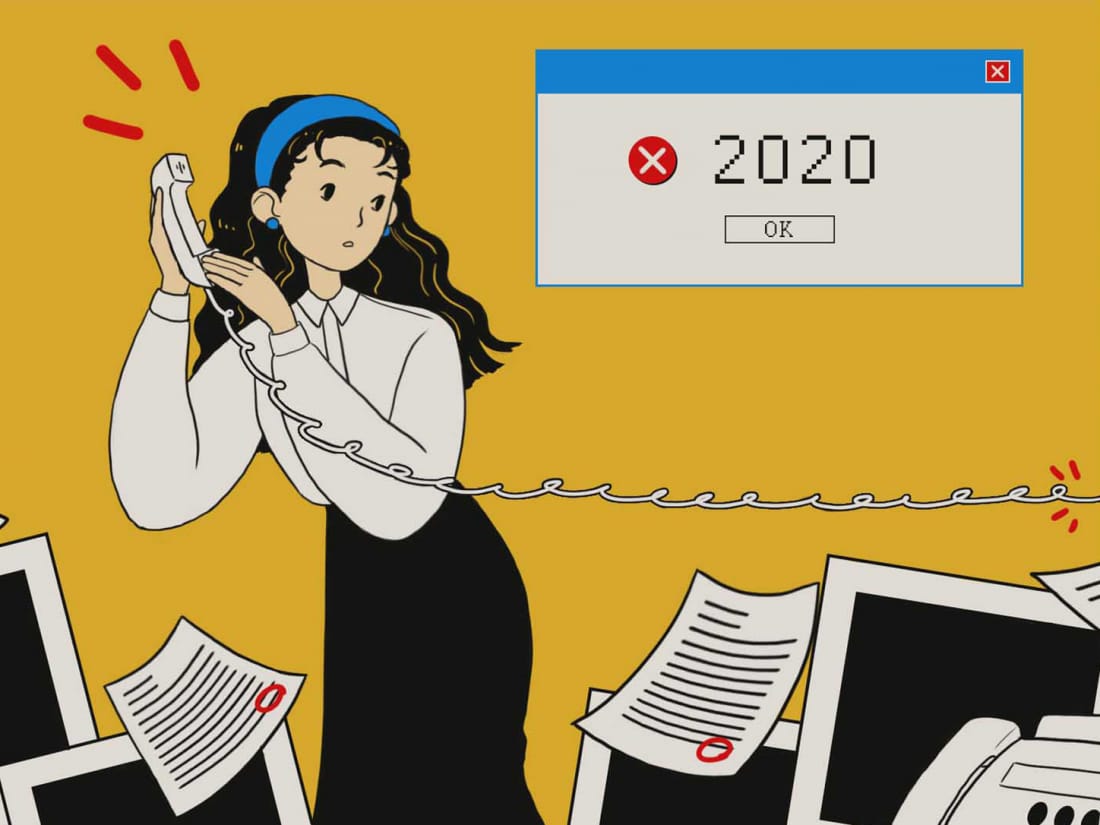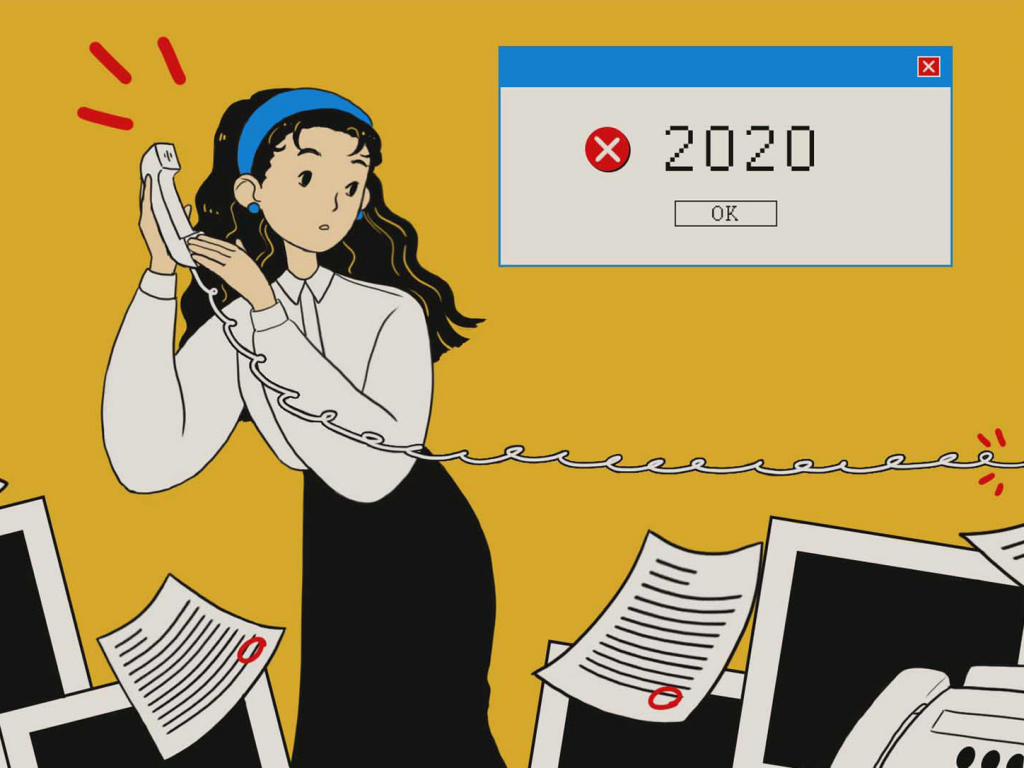
It’s funny that Japan has managed to retain its high-tech image throughout the 21st century. Yes, there are bullet trains zipping across the archipelago like space ships on rails, self-controlled vacuum cleaners that seem almost sentient, toilets which greet bums with fountains of water and choruses of birdsong, and talk of flying cars in the Tokyo Bay area as soon as 2023.
But peer behind the curtain and you’ll stumble upon a dirty little secret. In 2020, your typical Japanese office space looks more like the set of a drab ’90s sitcom than the world of the technical elite. Take a trip down to the local city hall and watch lines of people queue to get mounds of official paper stamped with an ancient seal, while dutiful workers carry out business on corded telephones, scrapheap computers and fax machines. Is this really the technological utopia of the future?
In 2019 Japan ranked 23rd out of 63 nations in digital competitiveness – the capacity of an economy to adopt and explore digital technologies leading to the transformation in government practices, business models and society in general. Or as economist, Yukio Noguchi, bluntly suggested: Japan’s administrative technology is 20 years behind the rest of the developed world.
Covid-19 sparked a minor revolution in remote-working and increased digitization of the workplace. With signs pointing toward an inflection point, could this be the catalyst to reset Japan’s archaic society?
The Future is Now, Isn’t it?
As the pandemic landed in developed countries, Zoom and Google Meets became the new norm for conducting business; both of which, were extensions of previously adopted virtual conference practices.
Japanese corporate culture, however, puts more emphasis on Shinkansen and plane journeys for face-to-face board room meetings. For many companies, adapting to the new ‘terewaku’ (telework) lifestyle was not a natural transition.
A survey, conducted by the Tokyo Chamber of Commerce and Industry in April, showed that only 26% of small- and medium-sized firms (which make almost 99% of the total companies in the capital) had introduced remote work plans. Of those who hadn’t implemented a system, over 30% attributed it to a lack of proper equipment.
Insufficient tools, sub-standard internet connections, and employees with ill-defined job roles free from the ever-present eyes of office superiors, made maximizing work-from-home productivity a nightmare.
When the state of emergency was implemented in April, crowds flooded electronic stores trying to equip themselves for teleworking; yet many would return to the office periodically over the proceeding weeks to print and hanko documents, or simply to show their faces.
Reinventing the Wheel
The government has expressed verbal support for digitization – as recently as July it asked companies to ensure up to 70 percent of their employees worked from home – but has yet to spearhead a real push in that direction. According to the Japan Research Institute, of the national government’s 55,000 administrative procedures only 7.5 percent can be done online. By any metric you please, this is clearly not enough.
Chizura Suga, head of The World Economic Forum’ Center for the Fourth Industrial Revolution of Japan, wrote in The Japan Times, “You can’t just build an expressway, you need cars that are capable of driving on it.”
Her metaphorical expressway would be a nationwide digital framework connecting individual strands of the bureaucracy and replacing analog channels of paper and ink. While the cars would include electronic IDs, data banks rather than filing cabinets, and the ubiquity of cashless payment systems.
Last month, the national government announced its digital new deal, which sets to address some of these issues. The policy includes updates to government websites – which look as though they were patched together on and old 1980s Commodore and are festering with malware – and increased data-sharing between ministries.
A Greener Future
Digitization and teleworking go hand in hand with environmental sustainability – another area where Japan has shown recent progress, but has long way to go.
In an interview earlier this year, Mika Ohbayashi of the Renewable Energy Institute, spoke to me of Japan’s much-needed shift towards greener cities and the decentralization from urban centers. If remote working becomes a mainstay of the Japanese corporate world – with the movement of data replacing the movement of people – it will facilitate this kind of sustainable progress.
Perhaps not surprisingly, major companies in the tech and IT sector have adapted most readily to the virtual workplace. Fujitsu is leading the vanguard, with aims to halve its office space (mostly congregated within the Tokyo metropolitan area) by 2023.
Hitachi is continuing to encourage up to 50 percent of its employees to eschew the workplace for the foreseeable future. Sony, Toshiba, NEC Communications and global company’s like Amazon and Google with Tokyo offices, are supporting similar measures long after the government’s social restrictions have ended.
Rural Regeneration
This could lead to decentralization on a national scale. Over 10% of Japanese businesses are located in Tokyo, along with 75% of Japan’s foreign company headquarters. The total GDP in 2016 (USD 1.6 trillion), put Tokyo as the 15th largest economy in the world, dwarfing entire nations like Canada, Spain and Australia. The metropolitan population, currently at around 38 million (of Japan’s 126 million total), is still growing at an annual rate of 0.8%, largely due to internal migration. Much of this is to the detriment of the rest of Japan.
However, if teleworkers are seldom required at the office and 5G internet connection becomes available across 100% of the country, paying astronomical rent for a shoebox room in central Tokyo becomes harder to justify. In May, suburban property listings in neighboring Kanagawa and Chiba prefectures saw huge online traffic increases, suggesting that Tokyo may finally be losing some of its inexorable pull.
This comes at a time when Japan is facing nationwide depopulation. More of the affluent middle classes moving to rural communities will help foster economic regeneration. Small towns are often living on borrowed time, dependent on tourism for survival; in the absence of inbound visitors, the need to share the wealth has never been more pressing.
It’s a shame it took something like a pandemic to pave the way for long-term change, but Japan must use this opportunity to carve out a better future.









